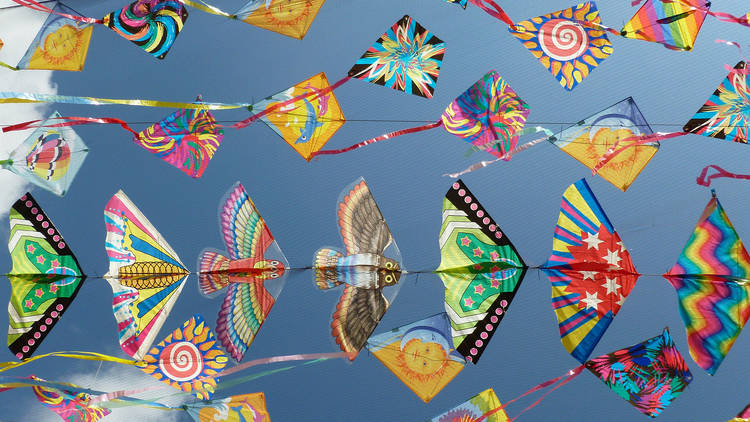Introduction
Kite flying, an age-old tradition celebrated across the globe, is an art that combines skill, precision, and craftsmanship. At the heart of this tradition lies the thread that connects the kite to its flyer—the manja and kite thread. In this blog, we will explore the different types of manja, the role of kite threads, and their significance in kite flying.
Manja: The Essence of Kite Battles
Manja, a special type of thread coated with a mixture of glue and finely crushed glass, is a critical component of kite flying, especially in regions like India and Pakistan. It serves a dual purpose: providing strength to the thread and making it razor-sharp for kite battles. Manja plays a pivotal role in cutting the opponent’s kite strings during friendly competitions.
1. Surati Manja: The Pride of Gujarat
Surati Manja is renowned for its high-quality craftsmanship and is named after the city of Surat in Gujarat, India. Gujarat is often considered the kite-flying capital of India, and Surati Manja is a testament to the state’s expertise in the art. It is made from a fine thread coated with a mixture of natural glues and powdered glass. The result is a sharp, strong, and smooth thread that kite flyers adore. Surati Manja is favored by many kite enthusiasts for its superior cutting ability and durability.
2. China Dori (Manja): The Budget-Friendly Option
China Dori, also known simply as “Chinese manja,” is a budget-friendly alternative to traditional Surati Manja. It is readily available in the market and offers a cost-effective solution for kite flying enthusiasts. While it may not match the sharpness and strength of Surati Manja, it is a popular choice for beginners and those looking for a more affordable option.
3. Mono Kite Manja: Single-Strand Strength
Mono Kite Manja, as the name suggests, is made from a single strand of high-quality thread coated with glass powder and adhesive. This type of manja is prized for its exceptional strength, making it a preferred choice for competitive kite battles. The single-strand design allows for precision control, making it easier to maneuver your kite in the sky.
4. Dragun Manja: The Ultimate Cutting Machine
Dragun Manja is known for its superior cutting ability. It’s named after the mythical creature “Dragon” due to its dragon-like sharpness. This type of manja is designed to be incredibly sharp, allowing kite flyers to easily cut the strings of their opponents. It’s a favorite among kite enthusiasts who seek the thrill of fierce kite battles.
5. Kite Thread: The Lifeline of Kite Flying
The kite thread, often referred to as “kite string,” is an integral part of the kite flying experience. It is the connection between the kite and the kite flyer, providing control and stability in the sky. The choice of kite thread can significantly impact the performance of your kite.
6. Kanch Ka Manja: Crystal-Clear Precision
Kanch Ka Manja, also known as “Crystal Manja,” is a special type of manja that contains finely powdered glass crystals. The presence of glass crystals on the manja thread enhances its cutting ability, making it exceptionally sharp. Kanch Ka Manja is often considered a top choice for those who want to engage in fierce kite battles, where precision is key.
7. King Panda: Strength and Durability
King Panda is a type of manja that strikes a balance between strength and durability. It is coated with powdered glass to enhance its cutting ability while maintaining a level of sturdiness that ensures it won’t break easily. Kite flyers appreciate King Panda for its versatility, as it allows them to engage in both recreational flying and competitive kite battles.
8. Tun Tun Manja: Tradition Meets Innovation
Tun Tun Manja is a unique combination of traditional craftsmanship and modern innovation. It offers the sharpness and strength of traditional manja with added features like glow-in-the-dark properties. This innovation allows for night-time kite flying, adding an extra dimension to the traditional art.
9. All-Out Manja: The Battle-Ready Choice
All-Out Manja, as the name suggests, is a type of manja designed for those who go all out in kite battles. It is coated with a thick layer of powdered glass to maximize its cutting ability. This type of manja is not for the faint of heart; it’s for those who are serious about winning battles in the sky.
Conversion from Yards to Meters:
Now that we’ve delved into the world of Manja and kite threads, let’s briefly touch upon converting a common measurement used in kite flying: yards to meters.
One yard is equal to approximately 0.9144 meters. To convert yards to meters, you can use the following formula:
Meters = Yards × 0.9144
For instance, if you have a kite thread that’s 1000 yards long and wants to know the equivalent length in meters:
Meters = 1000 yards × 0.9144 = 914.4 meters
So, 1000 yards is equivalent to approximately 914.4 meters.
Conclusion
Kite flying is not merely a pastime; it’s a celebration of culture, tradition, and skill. The choice of manja and kite thread is a reflection of the flyer’s expertise and preferences, and it can make or break a kite-flying experience. Whether you opt for the precision of Surati Manja, the budget-friendly China Dori, or the cutting-edge sharpness of Dragun Manja, each type of manja has its unique qualities. And the kite thread, regardless of its material and thickness, is the lifeline that connects you to the exhilarating world of kite flying. With the right combination of Manja and kite thread, you can take to the skies and engage in epic battles or leisurely flights, reveling in the joy that kite flying brings.
